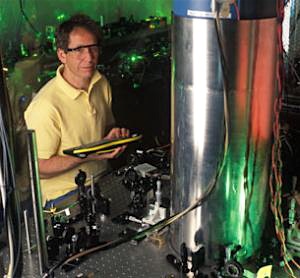Mercury Atomic Clock Keeps Time With Record Accuracy
An experimental atomic clock based on a single
mercury atom is now at least five times more precise than the national standard
clock based on a “fountain” of cesium atoms.

NIST physicist Jim Bergquist
An experimental atomic clock based on a single mercury atom is now at least five times more precise than the national standard clock based on a “fountain” of cesium atoms.
The experimental clock, which measures the oscillations of a mercury ion (an electrically charged atom) held in an ultra-cold electromagnetic trap, produces “ticks” at optical frequencies. Optical frequencies are much higher than the microwave f requencies measured in cesium atoms in NIST-F1, the national standard and one of the world’s most accurate clocks. Higher frequencies allow time to be divided into smaller units, which increases precision.
The current version of NIST-F1—if it were operated continuously—would neither gain nor lose a second in about 70 million years. The latest version of the mercury clock would neither gain nor lose a second in about 400 million years.
I thoroughly understand the usefulness of an advancement like this for science and mathematics.
That’s right. I haven’t worn a watch since 1986.
Posted: Sun - July 16, 2006 at 07:19 AM